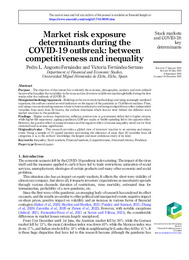Please use this identifier to cite or link to this item:
https://hdl.handle.net/11000/34486Full metadata record
| DC Field | Value | Language |
|---|---|---|
| dc.contributor.author | Angosto Fernández, Pedro | - |
| dc.contributor.author | Ferrandez-Serrano, Victoria | - |
| dc.contributor.other | Departamentos de la UMH::Estudios Económicos y Financieros | es_ES |
| dc.date.accessioned | 2025-01-15T11:10:10Z | - |
| dc.date.available | 2025-01-15T11:10:10Z | - |
| dc.date.created | 2023-12 | - |
| dc.identifier.citation | International Journal of Emerging Markets, 2023 | es_ES |
| dc.identifier.issn | 1746-8809 | - |
| dc.identifier.uri | https://hdl.handle.net/11000/34486 | - |
| dc.description.abstract | Purpose–Theobjective of this research is to identify the economic, demographic, sanitary and even cultural factors whichexplainthevariability inthe cross-sectionof returnsindifferentmarketsgloballyduringthefirst weeks after the outbreak of COVID-19. Design/methodology/approach–Buildingontheeventstudymethodologyandusingseeminglyunrelated equations, the authors created several indicators on the impact of the pandemic in 75 different markets. Then, andusingcross-sectionalregressionsrobusttoheteroscedasticityandusinganalgorithmtoselectindependent variables from more than 30 factors, the authors determine which factors were behind the different stock market reactions to the pandemic. Findings– Higher currency depreciation, inflation, interest rate or government deficit led to higher returns, while higher life expectancy, ageing population, GDP per capita or health spending led to the opposite effect. However, the positive effect of competitiveness and the negative effect of income inequality stand out for their statistical and economic significance. Originality/value– This research provides a global view of investors’ reaction to an extreme and unique event. Using a sample of 75 capital markets and testing the relevance of more than 30 variables from all categories, it is, to the authors’ knowledge, the largest and most ambitious study of its kind | es_ES |
| dc.format | application/pdf | es_ES |
| dc.format.extent | 28 | es_ES |
| dc.language.iso | eng | es_ES |
| dc.publisher | Emerald | es_ES |
| dc.rights | info:eu-repo/semantics/openAccess | es_ES |
| dc.rights | Attribution-NonCommercial-NoDerivatives 4.0 Internacional | * |
| dc.rights.uri | http://creativecommons.org/licenses/by-nc-nd/4.0/ | * |
| dc.subject | Inequality | es_ES |
| dc.subject | Stock markets | es_ES |
| dc.subject | Financial markets | es_ES |
| dc.subject | Competitiveness | es_ES |
| dc.subject | Abnormal returns | es_ES |
| dc.subject | Pandemic | es_ES |
| dc.subject.other | CDU::5 - Ciencias puras y naturales::50 - Generalidades sobre las ciencias puras | es_ES |
| dc.title | Market risk exposure determinants during the COVID-19 outbreak: between competitiveness and inequality | es_ES |
| dc.type | info:eu-repo/semantics/article | es_ES |
| dc.relation.publisherversion | https://doi.org/10.1108/IJOEM-01-2023-008 | es_ES |

View/Open:
5.- Market risk exposure determinants during COVID-19 outbreak (1).pdf
306,22 kB
Adobe PDF
Share:
.png)
